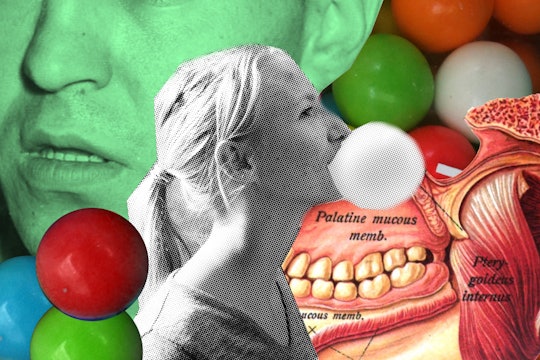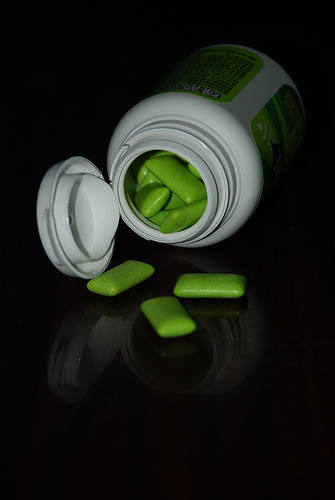
Photo illustration by Allan Lasser
Chewing gum could detect disease in saliva and deliver results via taste
Forget wearables, the hottest tech around is chewables
Nobody likes having their blood drawn. Peeing in a cup isn't so bad, but it's far from convenient. But typically, these are the biological fluids that nurses ask us to provide. Except for the finger prick of blood glucose testing, this usually must be done on location at a diagnostic lab. Upon relinquishing our ephemera, we go home and wait a few days for the results.
But what about spit? Saliva is a dispensable, non-invasive fluid that's full of ions, hormones, antibodies, and other proteins – it even contains DNA. And it's in your mouth, which is where it could stay while you test yourself at home.

Take one and call me if it turns bitter.
That's the goal of a team of European researchers who recently reported their efforts to develop a chewing gum self-test that gives users (chewers?) the result in minutes. And how do researchers propose delivering those results? Via a truly universal interface: taste.
Leaving an extremely bitter taste
The contents of a bodily fluid which are useful in diagnostics are called biomarkers, and if their levels are out of whack, it can indicate disease. The biomarker the researchers focused on, matrix metalloproteinases (MMPs), are more abundant during oral inflammation, which occurs during the mouth ailments periodontitis and gingivitis.
MMPs are proteins called proteases that break the chemical bonds of other proteins. Specifically, proteases target and cleave the peptide strands that make up a protein's building blocks. Different MMPs recognize and cleave different peptide targets. The authors take advantage of that feature in the design of their system, which identifies biomarker MMPs that cleave a peptide attached to the chewing gum, releasing a flavorful molecule.
If the test is positive, the gum will produce an intensely bitter taste shortly after someone starts chewing it. This is because the molecule released by MMP activity, denatonium, is the most bitter-tasting molecule known to science. Because it is so bitter, it can be detected at very low concentrations, making it a sensitive diagnostic tool. For example, the threshold for denatonium detection is 75 times lower than the spearmint-flavored carvone. Plus, it'd be unsettling to combine a good flavor and the bad result: "What a delightful wintergreen sensation, I guess I'd better get this disease taken care of." So they went with denatonium.
False start
At least, that was the plan. It didn't work at first. In studying the basic activity of the reporter molecule, the researchers set the gum aside and simply tested a peptide linked to denatonium, referred to hereafter as the probe. In this way the researchers could determine if MMPs would cleave the probe to release enough bitterness. The problem was, the probe didn't work well. MMPs did cleave it, but the denatonium was burdened by the leftover peptide fragment afterwards. That molecular baggage dampens the bitter sensation, decreasing the usefulness of the entire system.
A very clever probe redesign resulted in a cleaved fragment that could be further degraded by another protease present in saliva called salivary aminopeptidases (APs). Once the so-called second generation probe is cleaved by MMPs, APs chew off the remaining peptide fragment to reveal the unburdened denatonium in all its bitter glory.

An illustration of the described two-step bitter producer
Ritzer, J., Lühmann, T., Rode, C., Pein-Hackelbusch, M., Immohr, I., Schedler, U., … Meinel, L.
The researchers made further tweaks to the probe with purified MMPs and APs, but the true test was to see if the probe could identify oral disease from clinically diagnosed patients' saliva. They focused on peri-implant disease, because among oral inflammatory conditions, this one has a significant increase in MMPs. Currently, this condition is diagnosed at the periodontist's office, where the dentist harvests fluid from the gap between the patients' gum and the oral implant, and ships the sample off for lab testing.
It turned out the probe could discriminate between healthy and diseased saliva nearly as well as the lab test, with release of the denatonium occurring within 5-10 minutes in clinically-confirmed disease samples. Translated to gum, that would represent a good bit of chewing, but it's certainly more convenient than an office visit and waiting for test results.
Chew safety
But don't expect to be chewing your lab tests anytime soon. First off, the authors must demonstrate that the probe itself is safe before it'll enter a human mouth. Secondly, economics: the market of people looking for peri-implant disease-diagnosing chewing gum is slim to nonexistent.
However, this example could be extended to other protease biomarkers. For example, the bacteria Staphylococcus aureus expresses a protease called aureolysin, so a different peptide probe specific to that biomarker could aid identification of oral infections. The technological platform is in place; now it can be redirected to specific diseases in which saliva contains the relevant biomarkers.
Ever try to remember a time before the internet or smartphones and think, "How did we get by before?" Maybe in a decade we'll feel the same way as we chew up differently colored test gums at home. For what it's worth, the research team already applied for a patent and expect to commercialize a chewing gum diagnostic in the next two to three years. No syringes, no pee cups, no lab visits, no deductibles, no wait.
